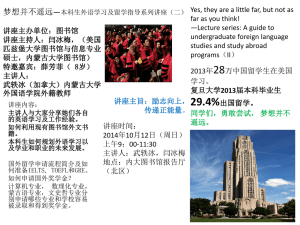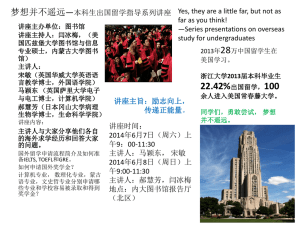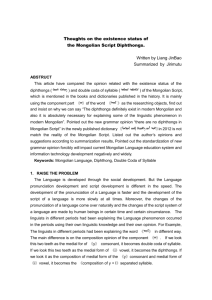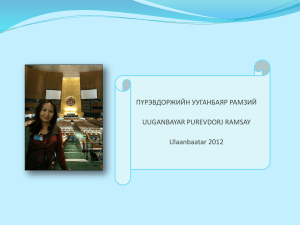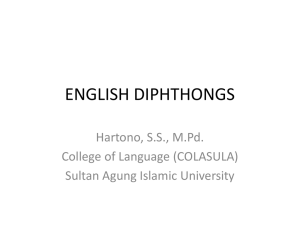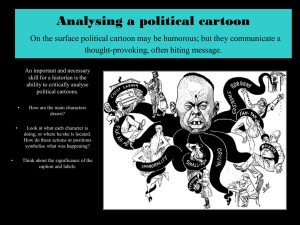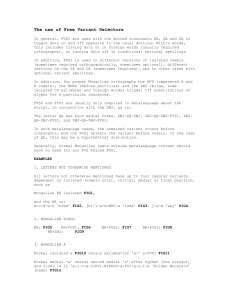InnerMongolianNormalUniversity_tranlation
advertisement
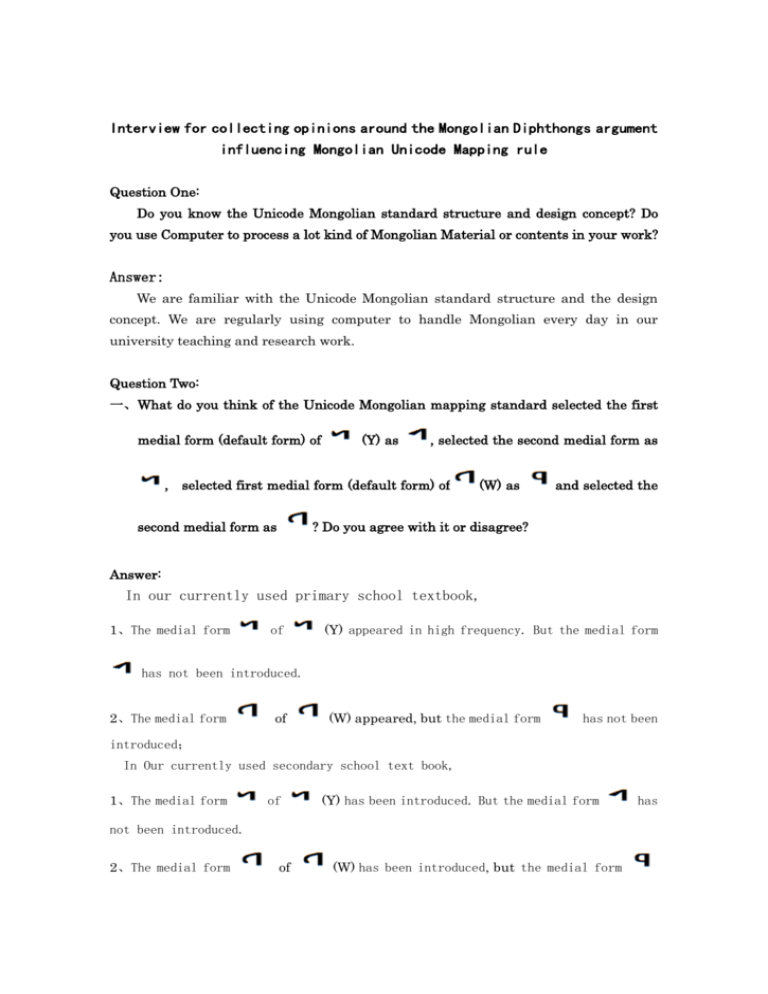
Interview for collecting opinions around the Mongolian Diphthongs argument influencing Mongolian Unicode Mapping rule Question One: Do you know the Unicode Mongolian standard structure and design concept? Do you use Computer to process a lot kind of Mongolian Material or contents in your work? Answer: We are familiar with the Unicode Mongolian standard structure and the design concept. We are regularly using computer to handle Mongolian every day in our university teaching and research work. Question Two: 一、 What do you think of the Unicode Mongolian mapping standard selected the first medial form (default form) of (Y) as , selected the second medial form as , selected first medial form (default form) of second medial form as (W) as and selected the ? Do you agree with it or disagree? Answer: In our currently used primary school textbook, 1、The medial form of (Y) appeared in high frequency. But the medial form has not been introduced. 2、The medial form of (W) appeared, but the medial form has not been introduced; In Our currently used secondary school text book, 1、The medial form of (Y) has been introduced. But the medial form not been introduced. 2、The medial form of (W) has been introduced, but the medial form has has not been introduced; We have investigated this in our university students who are using Mongolian language as their main lecture language. The situation is, 1、they know the medial form of they do not know the medial form 2、they know the medial form of But they do not know the medial form (Y) and they can list out example words. But , and cannot list out any example words (W) and they can list out example words. , and cannot list out any example words. According to the results listed above, It should be better to use the character’s usage frequency to decide the variant form selection order. We advise that we should encode the frequently used medial form as the first variant form (default form). 二、 Question Three: Do you have any opinion to the declaration of “Mongolian have no Diphthongs”? For Example: ᠠᠢᠯ encoded as <U+1820_A><U+1836_Y><U+1822_I><U+182F_L> 2ᠰᠠᠢᠬᠠᠨencoded as <U+1830_S><U+1820_A> 1 <U+1836_Y><U+1822_I><U+182C_H><U+1820_A><U+1828_N> ᠰᠠᠶᠢᠬᠠᠨ encoded as <U+1830_S><U+1820_A> 3 <U+1836_Y, FVS1><U+1822_I><U+182C_H><U+1820_A><U+1828_N> ᠳᠠᠢ encoded as<U+1832_T><U+1820_A><U+1836_Y> 4 Do you have any consideration for this kind of Mongolian encoding, storage, processing? Answer: In the generally used primary school and secondary school as well as high school textbook (Inner Mongolia Educational Publishing House 2004 version and 2012 version) which is appointed by teaching material of countrywide middle and primary school authorized committee, the words listed above frequently appears, all of them have been taught and learned in Mongolian Diphthongs theory. In the secondary school grammar book, the Mongolian Diphthongs theory have been introduced very clearly and definitely. If we accept the theory of “The Mongolian have no Diphthongs”, the Mongolian information searching and statistic logic will become more complex and ambitious. Because its medial form and final form will be encoded as differently. The written rule of diphthongs will become different between in the first syllable after (a)、 (e)、 (o)、 (u) and (i)、 (ö)、(ü) . It will become ambitious between the YI for the diphthong and the syllable with YI (although the syllable with YI does not exist in large amount). Question Four: What kind of impact will be there if we promote the theory of the Mongolian have no Diphthongs exists. How do you imagine if we promote this theory? Answer: If we promote the theory of Mongolian have no Diphthongs exist, it will significantly impact our education system. Now the entire textbook in primary and is using the Diphthong theory to explain all kind of these language phenomena. The Diphthong theory have been introducing in secondary school textbook definitely. The Diphthongs theory is same with the knowledge of all Mongolian People and easy to accept by them. The Diphthongs theory is clear on the concept and it will simplify the information search and statistic works which will be the base of all kind of other works, for example, exactly evaluating the education material and system’s quality. It will helpful for improving the Mongolian vocabulary as well as entire Mongolian language education quality. It will provide scientific suggestion for the Mongolian Language vocabulary education range and sequence definitely. Question Five: How do you handle the Mongolian Diphthongs or the encoding problem mentioned above? Do you have any plan to accept or promote the theory of “No Diphthongs exist in the Mongolian”? Answer: We are in doubt with this promotion. We think that the theory of “No Diphthongs exist in the Mongolian ” is still immature now. Because of linguistic knowledge limitation, we should need to refer from or discuss with linguists widely to come to the decision. We should carefully handle the Mongolian Information processing reality. Question Six: If you answered the question five as I want to accept or promote the theory of “No Diphthongs exist in the Mongolian”, please provide your explanation of the reason and the importance. If you answered the question five as I do not want to accept or promote the theory of “No Diphthongs exist in the Mongolian”, please provide your reason and the impact of the promotion. Answer: It is necessary to come to the decision after widely discussed and proven among the linguists, information technology experts as well as the educational experts. This theory has led a lot kind of technical problems for Mongolian information processing, like searching and statistic analyzing. It will led great impact to the primary school and secondary school education system. We think the promotion of the theory of “No Diphthongs exist in the Mongolian”is the sensitive issue for all Mongolian, It is still not a widely accepted theory now. We advise that we should treat it in caution. Inner Mongolia Normal University Computer Science Institute Song Yun, Has, Wang Serguleng, Lin Min 23 Dec 2015
